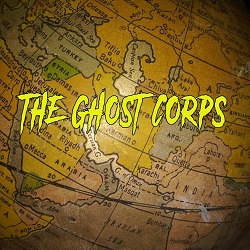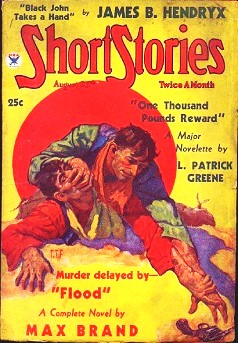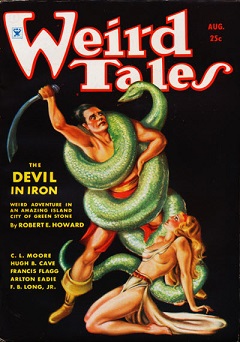
 Rest easy, dear reader, for The Ghost Corps refers not to supernatural beings that haunt graveyards and other habitations of living souls. The Ghost Corps is the name given to a mystery-shrouded organization of freelance diplomats operating throughout the near and Far East. At its head is C. D. Baker, who has a comprehensive intelligence network from which he receives word of trouble throughout the region, trouble most often begun by any one of the various warlords who make the Middle East their base of operations. K.C. Smith is one of the handful of independent diplomats owing allegiance to no one and no government, a man who is trained to handle the most fiendish lowlifes in the Middle East. He is fluent in all the Eastern dialects and is familiar with the many customs and centuries-old ways pervading this ancient land of bazaars, mosques, and even oriental palaces. Everyday, he ventures into the streets clothed in inconspicuous Middle Eastern garb, the better to blend in with those he lives amongst, and the better to glean any whispered information wafting his way, carried on the many breezes from exotic cities on land or merchant ships come to port from the sea, of foul plots that might harm others or the region of his adopted people. His own sources from the street plus information provided to him by C. D. Baker ensure that Smith will be well armed with the knowledge and tools necessary to take whatever action is necessary to thwart the never-ending schemes of the bloodthirsty warlords, all in the name of the Ghost Corps, those who walk in shadow and are known only to a few.
Rest easy, dear reader, for The Ghost Corps refers not to supernatural beings that haunt graveyards and other habitations of living souls. The Ghost Corps is the name given to a mystery-shrouded organization of freelance diplomats operating throughout the near and Far East. At its head is C. D. Baker, who has a comprehensive intelligence network from which he receives word of trouble throughout the region, trouble most often begun by any one of the various warlords who make the Middle East their base of operations. K.C. Smith is one of the handful of independent diplomats owing allegiance to no one and no government, a man who is trained to handle the most fiendish lowlifes in the Middle East. He is fluent in all the Eastern dialects and is familiar with the many customs and centuries-old ways pervading this ancient land of bazaars, mosques, and even oriental palaces. Everyday, he ventures into the streets clothed in inconspicuous Middle Eastern garb, the better to blend in with those he lives amongst, and the better to glean any whispered information wafting his way, carried on the many breezes from exotic cities on land or merchant ships come to port from the sea, of foul plots that might harm others or the region of his adopted people. His own sources from the street plus information provided to him by C. D. Baker ensure that Smith will be well armed with the knowledge and tools necessary to take whatever action is necessary to thwart the never-ending schemes of the bloodthirsty warlords, all in the name of the Ghost Corps, those who walk in shadow and are known only to a few.
[Photo top right was taken near the Al-Azhar mosque in Cairo, 1934]
The Ghost Corps, as closely as anyone can determine (or that I have been able to find), was broadcast sometime during the 1930s. One source claimed the air dates as 1934 but was unable to verify that assertion. The program consisted of two 13-part serials, each episode being between 14-15 minutes in duration. The first serial is the one we present the first three episodes of here, “The Knives of El Malik,” and the second is “The Prayer Rug of Nana Sieb.”
The name El Malik in the title of the first series has a long history, going back to pre-Semitic times. It has many derivative spellings and meanings, the most common being “king,” “ruler,” “sultan of Egypt,” or even one of the 99 names of God in Islam. The story arc of “The Knives of El Malik” revolves around the aforementioned El Malik at the heart of a rumored uprising of desert tribes, which, if successful, would leave the entire region in turmoil—political, economic, and with much bloodshed in its wake. It is up to K. C. Smith to quell the uprising before it begins, but to accomplish this unenviable task he must first assess what intelligence he has been given by his boss, add to it whatever supporting aid his underground informants can supply, before even beginning to design a strategy to counter the many bloodthirsty forces known as “The Knives of El Malik.”
The Knives of El Malik, Episode 1–“Ordered to Aswan”
Play Time: 14:15
The Knives of El Malik, Episode 2–“Finding Ali”
Play Time: 14:29
The Knives of El Malik, Episode 3–“Princess Amira”
Play Time: 14:41
{I couldn’t decide which vision of Princess Amira I liked best so offer all three.}



{Airing on a Saturday evening in August of 1934, the neighborhood gang was up and at it early after listening to episode 3 of “The Knives of El Malik” the night before and could hardly wait for the early church service to be over so they could make it home, change clothes, and head for their favorite home away from home. The corner newsstand was not safe with the gang on the loose, but the few nickels, dimes, and even the occasional quarter in the cash register each time they left made their visits worthwhile, especially during tough economic times. The gang was in luck this visit with some outstanding selections from which to choose. Astounding Stories (1930-present, now Analog) began a 7-part serial by Doc Smith, a Sky Lark novel no less, and part 5 of 6 of what would become one of Jack Williamson’s classic early romps, The Legion of Space. How lucky can you get! The magazine at this time was edited by F. Orlin Tremaine who some regarded, in his own way, as being as good as his successor, John W. Campbell, Jr. The magazine was monthly in 1934. Short Stories (1890-1959) was an amazing success story. It ran for an unbelievable 1,114 issues over its 70-year publishing span and offered stories in various genres, including adventure, western, foreign legion, Canadian Mountie, and others. It attracted talent from far and wide, including the renowned Max Brand in the issue featured below. Brand was the pseudonym of Frederick Schiller Faust (1892-1944) who wrote voluminously during his lifetime, with probably his best known work accruing from the stories (and then later movies) he created of one Dr. Kildare. Always up for a challenge and to live as much as he could real life experiences for the stories he would later write, he actually finagled (while drunk one night) an assignment with American foot soldiers in Italy in 1944. Unfortunately, he was mortally wounded and died on May 12, 1944. Throughout the 1930s Short Stories was published bi-weekly until it scaled back to a more reasonable monthly schedule in the middle of 1949. Weird Tales (1923-54) was the gold standard for supernatural horror for more than 30 years, its surviving issues now collector items at science fiction convention dealer rooms—when you can find them. A brief glance at many of the names on the cover below is testament to its high rank in the literature of the weird and supernatural: Robert E. Howard, C. L. Moore. Hugh B. Cave, and Frank Belknap Long. WT was a monthly in 1934.}
[Left: Astounding Stories, 8/34 – Center: Short Stories, 8-25/34 – Right: Weird Tales, 8/34]



To view the entire list of weekly Old Time Radio episodes at Tangent Online, click here.